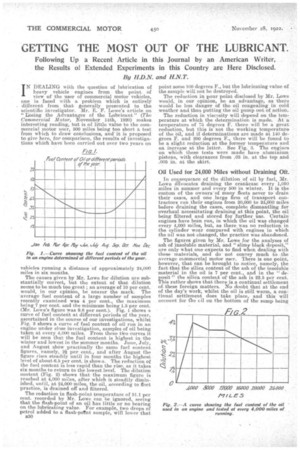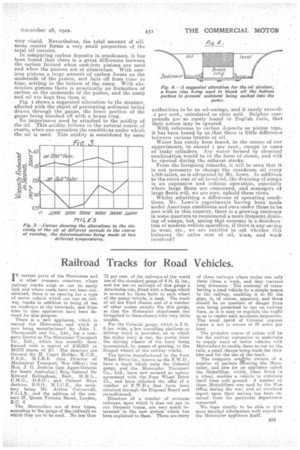GETTING THE MOST OUT OF THE LUBRICANT.
Page 14

Page 15

If you've noticed an error in this article please click here to report it so we can fix it.
Following Up a Recent Article in this Journal by an American Writer, the Results of Extended Experiments in this Country are Here Disclosed.
By H.D.N. and H.N.T.
IN DEALING with the question of lubrication of heavy vehicle engines from the point of view of the user of commercial motor vehicles, one is faced with a problem which is entirely different from that generally presented to the scientific investigator. Mr. E. F. Lowe's article on "Losing the Advantages of the Lubricant" (The Commercial Motor, November 14th, 1920) makes interesting reading, but is of little value to the commercial motor user, 500 Miles being too short a test from which to draw conclusions, and it is proposed to give here, for comparison, the results of investigations which have been carried out over two years on
vehicles running a distance of approximately 24,000 miles in six months.
The causes given by Mr. Lowe for dilution are substantially correct, but the extent of that dilution seems to be much too great ; an average of 10 per cent. would, in our opinion, be nearer the mark. The 'average fuel content of a large number of samples recently examined was 4 per cent., the maximum being 7 per cent. and the minimum being 1.5 per cent. (Mr. Lowe's figure was 9.6 per cent.). ]g. 1 shows a curve of fuel content at different periods of the year, ascertained in the course of our investigations, whilst Fig. 2 shows a curve of fuel content of oil run in an engine under close investigation, samples of oil being taken at every 4,000 miles. From these jive curves A will be seen that the fuel content is highest in-the winter and lowest in the summer months. June, July, and August show practically the same fuel content figures, namely, 2i per cent., arid after August the figure rises steadily until in four months the highest level of about 6.5 per cent, is shown. The reduction of i the fuel content s less rapid than the rise, as it takes six months to return to the lowest level. The dilution content (Fig. 2) shows that the. maximum figure is reached at 4,000 miles, after which it steadily diminished, until, at 24,000 miles, the oil, according to fleet practice, is drained off and filtered.
The reduction in flash-point temperature of 51.1 per cent, recorded by Mr. Lowe, can be ignored, seeing that the flash-point of an oil has little or no bearing on the lubricating value. For example, two drops of petrol added to a flash-potnt sample, will lower that 1330 point some 100 degrees F., but the lubricating value of the sample will not be destroyed.
The reduction in pour point disclosed by Mr. Lowe would, in our opinion, be an advantage, as there would be less danger of theoil congealing in cold weather and thus putting the oil pump out of action, The reduction in viscosity will depend on the temperature at which the determination is made. At a temperature of 75 degrees F. there will be a great reduction, but this is not the working temperature of the "oil, and if determinations are made at 140 degrees F. and 200 degrees F., there will be found to be a slight reduction at the former temperature and an increase at the latter.. See Fig. 3. The engines • on which these tests were made have aluminium pistons, with clearances from .03 in. at the top and .005 in. at the skirt.
Oil Used for 24,000 Miles without Draining Oft.
In consequence of the dilution of oil by fuel,. Mr. Lowe advocates draining the crankcase every 1,000 miles in summer and every 500 in winter. it is the custom of the owners-of many fleets never to drain their cases, and one large firm of transport contractors run their engines from 20,000 to 24,000 miles before draining the cases, complete dismantling for overhaul necessitating draining at this paint, the oil being filtered and stored for further use. Certain engines have been run, in which the oil was changed every 4,000 miles, but, as there was no reduction in the cylinder wear compared with engines in which the it was not changed, the practice was abandoned.
The figures given by Mr. Lowe for the analyses of ash of insoluble material, and "'slim? black deposit," are only what one expects to find when dealing with these materials, and do not convey much to the average commercial motor user. There is one point, however, that can be brought to notice, namely, the fact that the silica content of the ash of the insoluble material in the oil is 7 per cent. and in the " deposit " the silica content of the as:h is 22.5 per cent. This rather shows that there is a continual settlement of these foreign matters. No doubt that at the end of the day's work, whilst the oil is still warm, a con-. tinual settlement does take place, and this will accoun-t for the oil on the bottom of the sump being
very viscid. Nevertheless, the total amount of sili 'mous matter forms a very small proportion of the total oil content.
In comparing. carbon deposits in crankcases, it has been found that there is a -great difference between
the carbon formed when cast-iron pistons are used and when the pistons are of aluminium.. With cast
iron pistons a large amount of carbon forms on the Sediment underside of the piston, and falls Off from time to time, settling in the bottom of the sump. With aluminium.pistons there is practically no formation of carbon on the underside of the piston, and the sump and oil are kept free from it.
Fig. 4 shows .a suggested alteration to the strainer, effected with the object of preventing sediment being drawn through the gauze, the lower portion of the gauze being blanked off with a brass ring.
No importance need be attached to the acidity of the oil. This acidity follows in the natural course of evpnts, when one considers the conditions under which the oil is used. This acidity is eensidered by xorne
authorities to be an advantage, and it rarely excee.& .4 per cent., calculated as Gide, acid. Sulphur compounds are so rarely found in English fuels, that their action may be ignored.
With reference to carbon deposits on piston tops, it has been found by us that there is little difference between various brands of oil.
Water has rarely been found, in the course of our experiments, to exceed 1 per cent., except in eases of leaky cylinders. Any water formed by chemical combination would be in the form of steam, and will be ejected during the exhaust stroke.
From the foregoing remarks, it will be seen that it is not necessary to change the crankcase oil every 1,000 miles, as is advocated by Mr. Lowe. In addition to the extra cost of oil involved, the draining of sumpa is an expensive and tedious operation, especially where large fleets are concerned, and managers of large fleets will, we are sure, upheld these views.
Whilst admitting a difference of operating conditions, Mr. Lowe's experiments having been math: under American conditions and ours under those to be met with in this country, there is a growing tendency in some quarters to recommend a more frequent draisi.. ing of sumps, but, seeing that economy is a.desiderae tum of modern vehicle operation, if there is any saain&-, in wear, etc.,. we are entitled to ask whether ads balances the, extra eost Of oil, time, and work involved ?




























